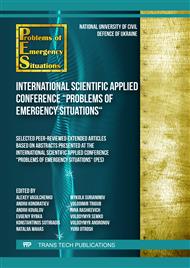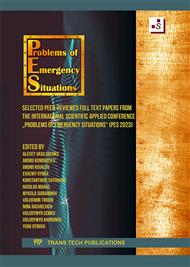[1]
A. Myroshnychenko, V. Loboichenko, M. Divizinyuk, A. Levterov, N. Rashkevich, O. Shevchenko, R. Shevchenko, Application of Up-to-Date Technologies for Monitoring the State of Surface Water in Populated Areas Affected by Hostilities, Bulletin of the georgian national academy of sciences, 16 3 (2022) 50–59.
Google Scholar
[2]
For the difference between bunkers and blockhouses see Schneider & Kitchen 2002, p.87, BACM Research 2009, p.263, Davis 2007, p.290.
Google Scholar
[3]
J. Nalewicki, (23 March 2016). "Switzerland's Historic Bunkers Get a New Lease on Life". The Smithsonian. Retrieved 4 April 2016.
Google Scholar
[4]
A. PAGE, Planning permanent air raid precautions: architecture, air war and the changing perceptions of British cities in the late 1930s, Urban History, 43(1) (2016) 117–134. https://www.jstor.org/stable/26398667
DOI: 10.1017/s0963926815000164
Google Scholar
[5]
S. Berger Ziauddin, (De)territorializing the home. The nuclear bomb shelter as a malleable site of passage, Environment and Planning D: Society and Space, 35 (2016).
DOI: 10.1177/0263775816677551
Google Scholar
[6]
P.N. Umnyakov, Engineering solutions implemented during the Great Patriotic war, Zhilishchnoe Stroitel'stvo [Housing Construction], 5 (2018) 25–28 [іn Russian].
Google Scholar
[7]
R.W. Nelson, Low-Yield Earth-Penetrating nuclear weapons, Science and Global Security, 10 (2002) 1–20.
DOI: 10.1080/08929880212326
Google Scholar
[8]
V.A. Kotlyarevsky, V.I. Ganushkin, A.A. Kostin and others, Shelters of civil defense. Designs and calculation, M.: Stroyizdat, (1989) 605 [іn Russian].
Google Scholar
[9]
Dr. Salam J. Al-Maliky, Basic Concepts for the Design of Nuclear Shelters and the Calculation of Wall Thickness Against a Nuclear Explosion of 20 Kt, Journal of Engineering and Development, 12 2 June 2008.
Google Scholar
[10]
Delbert B., Ward, "Fallout Shelter Standards", AusSurvivalist, National Conference of States on Building Codes and Standards, June 2005.
Google Scholar
[11]
George C., Bakos, "Calculation of γ-Radiation Converted to Thermal Energy in Nuclear Reactor Shielding Facilities", Journal of Annals of Nuclear Energy, Vol. 33, Issue 3, 2006.
DOI: 10.1016/j.anucene.2005.11.001
Google Scholar
[12]
E.V. Sazonov, V.V. Shichkin, Peculiarities of calculation of pneumatic conveying systems taking into accountmicroclimate of rooms. Housing and utilities infrastructure, 4(7) (2018) 29–40 [in Russian].
Google Scholar
[13]
Oleg V. Mkrtychev, Anton Y. Savenkov, Modelling of Blast Effects on Underground Structure, International Journal for Computational Civil and Structural Engineering, 15 4 (2019) 111–122.
DOI: 10.22337/2587-9618-2019-15-4-111-122
Google Scholar
[14]
Dorn Wolfgang, Zentralanatolien. Cologne: DuMont Verlag, 1997. ISBN 3-7701-2885-0 [in German].
Google Scholar
[15]
Kostof Spiro, Caves of God: Cappadocia and its Churches. – Oxford University Press, 1989. ISBN 0-19-506000-8 978-0195060003.
Google Scholar
[16]
Transport for London "Public Transport Journeys by Type of Transport". London Datastore. Archived from the original on 14 September 2021. Retrieved 14 September 2021, (23 August 2021).
Google Scholar
[17]
T.J. Coats, D.P. Walter, "Effect of station design on death in the London Underground: observational study", British Medical Journal, British Medical Association, 319 (7215) (9 October 1999) 957.
DOI: 10.1136/bmj.319.7215.957
Google Scholar



